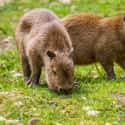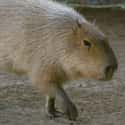-
(#6) Unlike A Lot Of Animals, Capybaras Can Get Sunburns
Typically appearing as reddish brown to gray, the capybara’s muted colors are one of their natural evolutionary developments. Another development, their thin, wiry coat, is designed to dry quickly when they exit the water.
Thus, sunburns become a possibility due to the capybara's thin coat. They counter this possibility by caking their skin in mud, another reason they’re known as water hogs. The capybara’s unique pelt also makes them a valuable hunting commodity, even in modern times.
-
(#1) Baby Capybaras Can't Swim
Though the majority of their lives will ultimately be spent in the water, newborn capybaras are not very good swimmers. As a result, they spend their first several months living near the water, hidden by large brush.
The entire capybara group works to nurse the young and protect them from harm. Baby capybaras nurse on every female in the community, and beta males work to stay vigilant to protect the group from harm.
-
(#8) How Can Capybaras Survive On Just A Grass Diet?
Thanks to special digestive adaptations, capybaras are able to extract an incredible amount of nutrients from their grass-based diet: “A large fermentation chamber, or cecum, in their intestines stores and churns the fibrous materials while mixing in bacteria, enzymes, and gases that aid in digestion.”
In addition, capybaras regurgitate their food three to four times during the eating process. They also eat their own droppings in order to ingest the highest possible percentage of nutrients. Talk about waste not, want not.
-
(#2) Capybaras Get To The Size Of A Small St. Bernard
Unlike most members of the rodent family, capybaras’ heads are flat and square-shaped. The females tend to be a little larger than the males, but in general they reach approximately the same physical size.
Capybaras can reach about four feet long and about 20 inches tall. Within that relatively small frame, capybaras pack a lot of density, weighing up to 175 pounds.
-
(#15) Pregnant Capybaras Have A Typical 120-Day Gestation Period
When pregnant, capybara mothers gestate young over a four-month period. Most commonly, capybara litters consist of about three pups. In rare cases, however, capybara mothers can give birth to as many as seven children.
The two-to-three pound pups are born with teeth. They subsist on their mother’s milk for the first four months of their lives. By the time they’re 18 weeks old, young capybaras can grow to be as big as 88 pounds. After about a year, capybara pups leave their parents’ group to find a new community.
-
(#3) Capybaras Are Most Commonly Active At Dawn And Dusk
When comfortable in their environment, capybaras act as crepuscular animals. This means they’re most often active at dawn and dusk, sleeping through the heat of the day and hiding out at night.
Should they feel as though a threat is present, capybaras can also convert to completely nocturnal behavior in which they eat and socialize entirely at night.
New Random Displays Display All By Ranking
About This Tool
You must have heard various stories about giant mice, but have you ever thought that there are 1 meter long mice in real life? It needs to explain that the capybara is not the mouse. Adult capybara can be 106-134 cm long, their short, sturdy limbs and webbed toes help them swim fast, and their short, tough fur can dry quickly. There are a lot of powerful animals in nature, but the one who is best at making friends is the capybara.
I believe you have seen photos that prove capybaras get along well with other animals, from turtles, birds, cats to monkeys. Capybara can be said to be the most popular animal in the animal kingdom. The random tool describes 16 fun facts about capybara, which you are sure to be interested in.
Our data comes from Ranker, If you want to participate in the ranking of items displayed on this page, please click here.
















